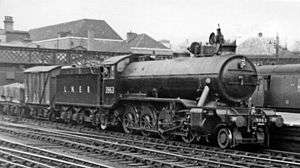2-8-0
Under the Whyte notation for the classification of steam locomotives, 2-8-0 represents the wheel arrangement of two leading wheels on one axle, usually in a leading truck, eight powered and coupled driving wheels on four axles, and no trailing wheels. In the United States and elsewhere, this wheel arrangement is commonly known as a Consolidation, after the Lehigh and Mahanoy Railroad’s Consolidation, the name of the first 2-8-0.[1]
 Front of locomotive at left | |||||||||||||||||
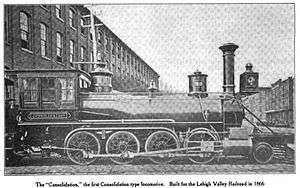 Lehigh and Mahanoy Railroad's Consolidation of 1866, the first 2-8-0 built | |||||||||||||||||
| |||||||||||||||||
| |||||||||||||||||
| |||||||||||||||||
| |||||||||||||||||
The Consolidation represented a notable advance in locomotive power. After 1875, it became "the most popular type of freight locomotive in the United States and was built in greater quantities than any other single wheel arrangement."[2]
Overview
Of all the locomotive types that were created and experimented with in the 19th century, the 2-8-0 was a relative latecomer.[3]
The first locomotive of this wheel arrangement was possibly built by the Pennsylvania Railroad (PRR). Like the first 2-6-0s, this first 2-8-0 had a leading axle that was rigidly attached to the locomotive's frame, rather than on a separate truck or bogie. To create this 2-8-0, PRR master mechanic John P. Laird modified an existing 0-8-0, the Bedford, between 1864 and 1865.
The 2-6-0 Mogul type, first created in the early 1860s, is often considered as the logical forerunner to the 2-8-0. However, a claim is made that the first true 2-8-0 engine evolved from the 0-8-0 and was ordered by the United States' Lehigh and Mahanoy Railroad, which named all its engines. The name given to the new locomotive was Consolidation, the name that was later almost globally adopted for the type. According to this viewpoint, the first 2-8-0 order by Lehigh dates to 1866 and antedates the adoption of the type by other railways and coal and mountain freight haulers.[3]
From its introduction in 1866 and well into the early 20th century, the 2-8-0 design was considered to be the ultimate heavy-freight locomotive. The 2-8-0's forte was starting and moving "impressive loads at unimpressive speeds" and its versatility gave the type its longevity. The practical limit of the design was reached in 1915, when it was realised that no further development was possible with a locomotive of this wheel arrangement.[3]
Usage
As in the United States, the 2-8-0 was also a popular type in Europe, again largely as a freight hauler. The type was also used in Australia, New Zealand, and Southern Africa.
Australia
The 2-8-0 locomotive was used extensively throughout Australia. It served on the 5 ft 3 in (1,600 mm) broad gauge, 4 ft 8 1⁄2 in (1,435 mm) standard gauge and 3 ft 6 in (1,067 mm) narrow gauge and was employed mostly as a freight locomotive, although it was often also employed in passenger service in Victoria.[4]
The first Australian locomotive class with this wheel arrangement consisted of 20 standard-gauge New South Wales Government Railways (NSWGR) J Class engines, which arrived from Baldwin Locomotive Works in 1891. The Js remained in service in New South Wales until 1915, when they were withdrawn. Wartime shortages between 1916 and 1920 had six engines re-entering service after being shopped and fitted with superheaters. The last engine of this class was finally withdrawn in 1934 and all were scrapped by 1937.[4]
The second batch of 2-8-0 locomotives to appear in Australia, between 1896 and 1916, was the NSWGR T class engines. The class was delivered from one local and several overseas builders, 151 locomotives from Beyer, Peacock and Company, 84 from North British Locomotive Company, 10 from Neilson and Company, 30 from Clyde Engineering in Australia, and five from Dübs and Company. During World War II, 14 of these locomotives were equipped with superheaters, which raised their tractive effort from 28,777 lbf (128.0 kN) to 33,557 lbf (149.3 kN).[4]
From 1899, the Victorian Railways (VR) also used a range of broad-gauge 2-8-0 locomotives.
- The first of these locomotives were the Baldwin-built Victorian Railways V class. These engines were built at Phoenix Foundry in Ballarat, Victoria. By 1930, they had disappeared from the VR.
- The VR's next type was the 26 C class engines, which saw freight and passenger service.
- In 1922, a smaller and lighter 2-8-0, the K class, was introduced for branchline freight and later also passenger services.
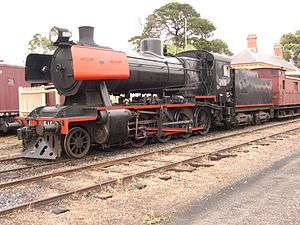
- Finally, the VR introduced sixty light 2-8-0 J class engines in 1954. These also worked both freight and passenger services.[4]
The first 2-8-0 engines in private service on the Midland Railway of Western Australia arrived in 1912. These were 3 ft 6 in (1,067 mm) gauge locomotives. The five in the class operated until 1958. All were gone by 1963.[4]
In 1912, some of the NSWGR T class types were also purchased by the private East Greta Railway, later to become the South Maitland Railway, but these were converted to 2-8-2 tank locomotives. The class proved to be successful throughout its long service life, until being retired from government revenue service in 1973.[4]
During 1916, several of these same T class engines were also purchased from NBL by the Commonwealth Railways for the Trans-Australian Railway.[4]
In 1924, a private coal company, J&A Brown in NSW, obtained three ex-British military Railway Operating Division ROD 2-8-0 locomotives. Brown later ordered another 10 of these locomotives, but only nine of that order arrived in Australia. The last was withdrawn in 1973.[4]
Belgium
To compensate for wartime losses, Belgian railways acquired 300 2-8-0 locomotives in 1946. They were built in North America, 160 by Montreal Locomotive Works in Canada, 60 by the Canadian Locomotive Company, and 80 by the American Locomotive Company in the United States. These machines proved to be very reliable and were used for mixed traffic until the end of the steam era, when number 29.013 hauled the last scheduled steam passenger train from Ath to Denderleeuw on 20 December 1966.[5]
This locomotive survived in preservation and is used on special excursions. On 16 December 2006, number 29.013 re-enacted the last 1966 run on the same route.[6]
Canada
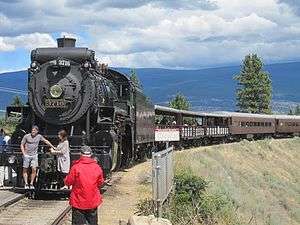
The Canadian Pacific Railway (CP) N-2-a, b, and c class locomotives were a class of altogether 182 Consolidation type locomotives, built by Montreal Locomotive Works between 1912 and 1914. They were numbered in the range from 3600 to 3799 and were used almost everywhere around the system. The order for these engines came about when CP needed bigger locomotives for their mainline since their current engines were wearing out and were too small for the loads that were being hauled. Most of the class were converted to oil-firing in later years.[7][8]
One of the locomotives, No. 3716, is run and maintained in Summerland, BC as part of the Kettle Valley Steam Railway.[9][10]
Finland
Finland had five tender locomotive classes with a 2-8-0 wheel arrangement, the classes Tk1, Tk2, Tk3, Tv1, and Tv2. The class Tk1s were numbered from 271 to 290 and were nicknamed Amerikan Satikka.
The class Tk2s were numbered 407 to 426 and 457 to 470. They were nicknamed Satikka. Three were preserved, No. 407 at Närpes, No. 418 at Junction City, Oregon, in the United States, and No. 419 at Haapamäki. The class Tk3s were numbered 800 to 899, 1100 to 1118, and 1129 to 1170. They were built by Tampella, Lokomo, and Frichs. The class Tv1s were numbered 594 to 617, 685 to 741, 900 to 948, and 1200 to 1211. They were built by Tampella and were nicknamed Jumbo. Four were preserved, No. 609 at Haapamäki, No. 933 at the Veturi museum at Toijala, No. 940 at Lapinlahti and No. 943 at Ylivieska. The class Tv2s were numbered from 618 to 637. They were nicknamed Wilson. Only No. 618 was preserved, also at Haapamäki.
Finland had only one tank locomotive class with a 2-8-0 wheel arrangement, the class M1 consisting of one solitary locomotive numbered 66. It was not preserved.
Germany
The 2-8-0 wheel arrangement enjoyed a brief period of popularity in Germany during the era of the Länderbahnen or State Railways, from about 1840 to 1920, prior to the establishment after the First World War of the Deutsche Reichsbahn, the German National Railways. Under the Deutsche Reichsbahn-Gesellschaft (DRG) classification system, all 2-8-0 locomotives were assigned to class 56 (Baureihe or BR 56), with different types receiving subclassifications. The earliest type was the Prussian G73 of 1893.
Italy
In Italy, the state-controlled railways company Ferrovie dello Stato (FS), after comparing two models of 2-8-0 engine in 1906 (a simple-expansion [simplex] locomotive purchased from Baldwin and a compound type assembled by German and Italian builders) opted for a simplex 2-8-0 as basic power for its freight and mixed trains. Production of such locomotives, classified Gr. 740 in Italy, began in 1911 and stopped four years later when Italy entered the First World War.
Thereafter, Italian industry was devoted to producing military equipment, so FS bought locomotives from North American firms. From 1917 to 1922, American Locomotive Company and Montreal Locomotive Works built almost 393 2-8-0 locomotives for Italy. The FS classified these engines as Gr 735 and used them for freight and passenger services. After the war, the supply of Italian-built Gr. 740 resumed. Both Gr. 740 and Gr 735, very similar in performance, remained in service until the end of the 1960s.
New Zealand
Several 2-8-0 locomotives were supplied to New Zealand by the Baldwin Locomotive Works of Philadelphia in the United States. Six O Class locomotives were built for the New Zealand Railways in 1885.
The Wellington and Manawatu Railway Company, which operated the Wellington-Manawatu line, had four similar locomotives built by Baldwin, two in 1888, one in 1894 and one in 1896. The WMR locomotives of 1894 and 1896, No. 12 and No. 13, were Vauclain compound locomotives, the first in New Zealand and the first narrow-gauge compounds in the world. While standard gauge compounds usually had the low-pressure cylinder mounted below the high-pressure cylinder on each side, this was often reversed on narrow-gauge locomotives, which had the larger low-pressure cylinders mounted above the high-pressure cylinders to provide greater clearance at platforms.
In 1908, when the WMR was nationalized, these locomotives were classified into three NZR subclasses because of detail differences, the two 1888 locomotives as OB class, the 1894 locomotive as OA class, and the 1896 locomotive as OC class.
North Korea
The Korean State Railway have locally built 500-series (used by rubber recycling plant[11]) and 810 series Japanese built[12] narrow gauge (762mm) 2-8-0 locomotives. The 810 series was likely retired in 2006 and 500-series may still be operating.
Russia
In Russia, the 2-8-0 wheel arrangement was represented by the prerevolutionary Sch (Shuka-pike) class. These two-cylinder compound locomotives without superheaters were declared the standard Russian freight locomotive in 1912, but since they were relatively low-powered, they were only useful on easier lines without steep gradients such as the Saint Petersburg-Moscow route.
South Africa
Five 2-8-0 locomotive classes saw service in South Africa, all of them initially acquired by the Cape Government Railways (CGR), which classified all but two as 8th Class. All of them were variations on the same design, used saturated steam, and had cylinders with overhead slide valves, actuated by inside Stephenson valve gear.[13]
.jpg)
- In 1901 and 1902, the CGR placed 16 Consolidations in service. Designed by H.M. Beatty, chief locomotive superintendent of the CGR from 1896 to 1910, they were ordered from the Schenectady Locomotive Works in the United States and partly delivered by Schenectady in 1901, with the remainder delivered from the newly established American Locomotive Company in 1902. Conceived as mixed-traffic locomotives, they had bar frames and narrow fireboxes. In 1912, when these locomotives were assimilated into the South African Railways (SAR), they were designated Class 8X.[13][14][15][16]
- In 1902, the CGR also placed a single experimental tandem compound Consolidation in service, based on its Schenectady/ALCO-built 8th Class. Delivered by ALCO in 1902, the locomotive was not classified and was simply referred to as the Tandem Compound. In 1912, it was designated Class Experimental 2 on the SAR.[13][14][15]
- In 1903, the CGR received a second experimental tandem compound Consolidation from ALCO. It was similar to the earlier one, but with a larger fire grate and an increased heating surface which enhanced its steaming ability. It also remained unclassified and was also simply referred to as a Tandem Compound. In 1912, it was designated Class Experimental 3 on the SAR.[13][14][15]
- Also in 1903, the CGR received four more Consolidations from Kitson and Company of Hunslet in Leeds. They were very similar to the earlier Schenectady and ALCO-built Consolidations, but with the boiler pitch raised by 2 in (51 mm). Coupled with a shallow firebox, this enabled the grate to be extended out sideways over the fourth set of drivers, resulting in a grate area of 30.9 sq ft (2.871 m2) compared to the 20 sq ft (1.858 m2) of the previous model. In 1912, they were designated Class 8Y on the SAR.[13][14][15]
- In 1904, the CGR placed its last eight Consolidations in service. These were ordered from the North British Locomotive Company of Glasgow in Scotland and were very similar to the previous four Kitson-built locomotives, but slightly larger in boiler and firegrate area dimensions. In 1912, these eight were designated Class 8Z on the SAR.[13][14][15][17]
While subjecting the Consolidations to exhaustive testing on all types of traffic and under varying conditions, some trouble was experienced with the leading pony truck and it was dropped in favour of a four-wheeled bogie in later orders for more eighth class locomotives. All subsequent Cape eighth class locomotives were therefore built with a 4-8-0 Mastodon wheel arrangement.[13]
South West Africa
In 1907 and 1910, the Staatsbahn Keetmanshoop (Keetmanshoop State Railway) in German South West Africa placed 21 tank locomotives in service. After the first World War, when all railways in the territory came under the administration of the South African Railways in 1922, five locomotives of the batch of 1910 survived. They were not classified or renumbered, but were referred to as the eight-coupled tanks.[14][18]
In 1911, nine tender locomotives were placed in service by the Staatsbahn Lüderitzbucht-Keetmanshoop (Lüderitzbucht-Keetmanshoop State Railway). After the first World War, all nine locomotives came onto the roster of the SAR, where they were referred to as the eight-coupled tenders.[14][18]
Turkey
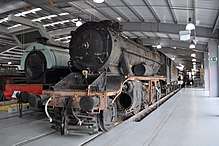
Turkey was a neutral country during the Second World War and to retain Turkish goodwill, Great Britain supplied several locomotives to the Turkish Railways, where they were classified 8F.
Two of these 8F class locomotives were brought back from Turkey early in 2011 and one of them is on display at the National Railway Museum in Shildon, England.
United Kingdom
The 2-8-0 gradually became the standard heavy-freight steam locomotive type in the United Kingdom during the first half of the 20th century. The first 2-8-0 to be built in Britain was the Great Western Railway's 2800 Class, with 84 locomotives built between 1903 and 1919, followed by a further 83 of the very similar GWR 2884 Class between 1938 and 1942. In 1904, George Whale of the London and North Western Railway (LNWR) began to rebuild some of his predecessor's 0-8-0 compound locomotives to 2-8-0.
In 1911, John G. Robinson of the Great Central Railway (GCR) introduced his very successful GCR Class 8K for heavy freight. 129 of these were originally built by the GCR. During the First World War, the design was adopted by the Ministry of Munitions and it became the standard locomotive of the Railway Operating Division of the Royal Engineers as the ROD 2-8-0. Altogether, 521 of these ROD locomotives were built during the war. After the war, large numbers of these were purchased by the LNWR and GWR, while some were also sold to a private Australian coal company, J&A Brown in New South Wales. Altogether, 273 were purchased by the LNWR during the early 1920s.[4]
Other successful 2-8-0 designs were built in the UK. The classes O1 and O2 were introduced by Nigel Gresley of the Great Northern Railway in 1913 and 1918, respectively, and the Class 7F by Henry Fowler of the Somerset and Dorset Joint Railway in 1914.
The most successful British 2-8-0 class was the Class 8F, designed in 1935 by William Stanier for the London Midland and Scottish Railway. By 1946, 852 had been built. During the Second World War, the War Department originally chose the class 8F as its standard freight locomotive, and large numbers of them saw service overseas, notably in the Middle East.
The class 8F was superseded after 1943 by the cheaper WD Austerity 2-8-0 for war service. A total of 935 of these were built and again, many saw service overseas.
United States
.jpg)
.jpg)

In the United States, only a few railroads purchased Consolidation types when Baldwin Locomotive Works first introduced its version. Even the Baltimore & Ohio railroad, which eventually had nearly 180 2-8-0 locomotives in regular service by 1885, did not purchase any of this type until 1873. The Buffalo, Rochester and Pittsburgh Railway, which eventually became part of B&O, purchased 15 of this type from Brooks Locomotive Works in 1883.[19]
The 2-8-0 design was given a major boost in 1875, when the Pennsylvania Railroad made it their standard freight locomotive, and 1875 was also when the Erie Railroad began replacing its 4-4-0s in freight service with 2-8-0s. The railroads had found that the 2-8-0 could move trains twice as heavy at half the cost of its predecessors. From a financial standpoint at the time, the choice of the 2-8-0 as new freight locomotive was therefore clear.[19]
The S160 Class of the United States Army Transportation Corps was built by American manufacturers and was designed for use in Europe for heavy freight work during the Second World War. A total of 2,120 of this class was built and they worked on railroads across the world. Production of the 2-8-0 type in the United States totalled more than 23,000 locomotives, of which 12,000 were export versions.[20]
Preservation
Great Northern Railway Consolidation No. 1147 is on display in a park in Wenatchee, Washington.
Great Northern Railway Consolidation No. 1246 is in storage in southern Oregon.
Southern Pacific No. 895, a 2-8-0 Consolidation locomotive built by ALCO in 1913 is on static display at Roseland Park in Baytown, Texas. SP No. 895 was retired after 44 years of service and donated by Southern Pacific Railroad to the Robert E. Lee High School Key Club, then towed on temporary tracks to its current location at Roseland Park in April, 1957.
One of B&O's 2-8-0 Consolidations, built in 1888, is preserved at the B&O Railroad Museum in Baltimore, Maryland.
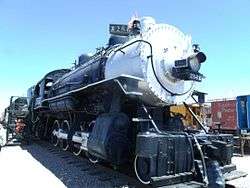
The Southern Pacific Railroad's locomotive no. SP 2562 was built by the Baldwin Locomotive Works in 1909, serial No. 29064. It is on exhibit in the Arizona Railway Museum in Chandler, Arizona. The locomotive and its tender are listed in the National Register of Historic Places, reference No. 09000511.
The Atchison, Topeka, and Santa Fe Railroad's class 759 locomotive No. 761 was built around 1890. When active, it was used on the railroad's mainline between Chicago and the west. No. 761 is plinthed next to the historic Wickenburg, Arizona, train depot that is now the town's visitor center.
The Colorado & Southern (C&S) narrow-gauge No. 60 is on display in Idaho Springs, Colorado, while C&S No. 71 is in Central City, Colorado.
A Ks1 class 2-8-0, No. 630, is run and maintained in Chattanooga, Tennessee, by the Tennessee Valley Railroad Museum. In 2014, this locomotive participated in the Norfolk Southern 21st Century Steam program.
In 1962, the Arcade & Attica Railroad purchased an ALCO-build locomotive from the Boyne City Railroad in Michigan. The locomotive, now numbered 18, is billed as the last operating steam excursion in New York State.[21]
In 1992, the Western Maryland Scenic Railroad acquired a 1916 Baldwin Lake Superior and Ispheming railroad 2-8-0 which was numbered 34. The locomotive was restored to operating condition and changed cosmetically to look like an original Western Maryland Railway 2-8-0. The locomotive was renumbered to 734 in honor, so to speak, of the H-7 (701-764) class of 2-8-0 that the Western Maryland harbored and of which none was preserved.
UPRR No. 561 is on static display along US Highway 81 in Columbus, NE.
UPRR No. 423 is on static display on 10th street in Gering, Ne.
UPRR No. 6072 is on static display at Wyman park in Fort Riley ks.
Baldwin Locomotive Works No. 40, built in December 1925 for the Lancaster and Chester Railroad in South Carolina, and later purchased by the Cliffside Railroad in North Carolina, now pulls scenic excursion trains at the New Hope and Ivyland Railroad in New Hope, Pennsylvania, which opened in August, 1966.
Great Western No. 60, built in August 1937 by the American Locomotive Company in Schenectady, New York, is currently operated on the Black River and Western Railroad in Ringoes, New Jersey. No. 60 originally operated on the Great Western Railway of Colorado.
Baldwin Steam Locomotive No. 1702, built in 1942 for the United States Army, was purchased by the Great Smoky Mountains Railroad (GSMR) of Bryson City, North Carolina, in the mid-1990s for use on its scenic railway excursions. After a decade of service, No. 1702 was retired in 2004. In October 2012, a partnership formed between GSMR and Swain County to provide funding to restore the locomotive. In 2013, a complete restoration was launched and the locomotive returned to service during summer 2016.
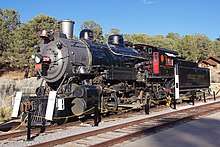
In the late 1980s, four ex-Lake Superior and Ispheming 2-8-0s were leased by the Grand Canyon Railway based in Williams, Arizona. No. 14 was built by ALCO in 1906 and was eventually renumbered 29, while Nos. 18, 19, and 20 were also built be ALCO in 1910. Nos. 19 and 20 were cosmetically restored for static display at Williams Depot while 18 and 29 were fully restored to operation for use between Williams and the Grand Canyon National Park. In 2006, the Grand Canyon Railway sold off almost all of their 2-8-0s. No. 19 was purchased by the City of Frisco, Texas specifically for use on static display, appearing as a typical Frisco locomotive. The Frisco operated a fleet of over 200 consolidations before dieselization in the 1950s.[22] Nos. 18 and 20 now reside at the Rio Grande Scenic Railroad based in Alamosa, Colorado, where 18 is often used in excusion service while 20 remains in dead storage. As of now, No. 29 remains as the only 2-8-0 homed at the Grand Canyon Railway.
Pennsylvania Railroad 1187, of the class R, later H3, is on display at the Railroad Museum of Pennsylvania. This class is described in detail in the book Set Up Running: The Life of a Pennsylvania Railroad Engineman 1904-1949.
References
| Wikimedia Commons has media related to 2-8-0. |
- White, John H., Jr. (1968). A history of the American locomotive; its development: 1830-1880. New York: Dover Publications, p. 65. ISBN 0-486-23818-0
- White, John H. (1979). A History of the American Locomotive: Its Development, 1830-1880. New York: Dover Publications. p. 65. ISBN 0486238180. Retrieved 22 July 2019.
- Swengel, F.M. (1967). The American Steam Locomotive: Vol. 1, the Evolution of the Steam Locomotive. Davenport: Midwest Rail Publishing, pp. 16, 102, 134, 186.
- Oberg, Leon. (1975). Locomotives of Australia. Sydney: Reed.
- "40 jaar Einde stoomtractie". Archived from the original on 2007-09-28. Retrieved 2007-12-23.
- "Herstelde stoomlocomotief type 29 zaterdag terug in België" (Press release) (in Dutch). NMBS. 2003-06-11. Archived from the original on 2007-09-27. Retrieved 2007-02-23.
- Lavallée, Omer (1985). Canadian Pacific Railway Diagrams and Data: Steam Locomotives. Vol. 1 (2nd ed.). West Hill, Ont.: Railfare Enterprises. pp. 45–46.
- Doeksen, Corwin; Doeksen, Gerry (1991). Railways of the West Kootenay. Vol. 1. Montrose, B.C.: Doeksen. p. 56.
- Kettle Valley Model Railway - Kettle Valley Consolidations Part 2 Archived 2016-10-02 at the Wayback Machine (Accessed on 22 October 2016)
- Kettle Valley Model Railway - Kettle Valley Consolidations Part 3 Archived 2016-10-22 at the Wayback Machine (Accessed on 22 October 2016)
- newslabmedia (15 January 2012). "North-Korean Steam locomotive 5 - Narrow gauge". Archived from the original on 7 June 2014 – via YouTube.
- Seiler, Bernd. "Last Steam in North Korea". www.farrail.net. Archived from the original on 2014-09-23.
- Holland, D.F. (1971). Steam Locomotives of the South African Railways. 1: 1859–1910 (1st ed.). Newton Abbott, Devon: David & Charles. pp. 61–68. ISBN 978-0-7153-5382-0.
- Paxton, Leith; Bourne, David (1985). Locomotives of the South African Railways (1st ed.). Cape Town: Struik. pp. 50, 82, 99, 149. ISBN 0869772112.
- Classification of S.A.R. Engines with Renumbering Lists, issued by the Chief Mechanical Engineer's Office, Pretoria, January 1912, pp. 9, 12, 15, 35-36 (Reprinted in April 1987 by SATS Museum, R.3125-6/9/11-1000)
- South African Railways and Harbours Locomotive Diagram Book, 2’0" & 3’6" Gauge Steam Locomotives, p11, 15 August 1941, as amended
- North British Locomotive Company works list, compiled by Austrian locomotive historian Bernhard Schmeiser
- Dulez, Jean A. (2012). Railways of Southern Africa 150 Years (Commemorating One Hundred and Fifty Years of Railways on the Sub-Continent – Complete Motive Power Classifications and Famous Trains – 1860–2011) (1st ed.). Garden View, Johannesburg, South Africa: Vidrail Productions. p. 35. ISBN 9 780620 512282.
- Kinert, Reed. (1962). Early American steam locomotives - 1st seven decades: 1830-1900. Seattle, WA: Superior Publishing Company.
- American-Rails.com - The 2-8-0 Consolidation Type Archived 2016-11-09 at the Wayback Machine (Accessed on 9 November 2016)
- https://www.aarailroad.com/about-us, Retrieved 12-06-18.
- http://www.steamlocomotive.com/mikado/?page=slsf Archived 2017-06-11 at the Wayback Machine, Retrieved 6-11-15.
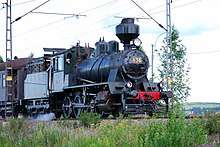
_CGR_839.jpg)
_CGR_825.jpg)
_ex_DSWA.jpg)
